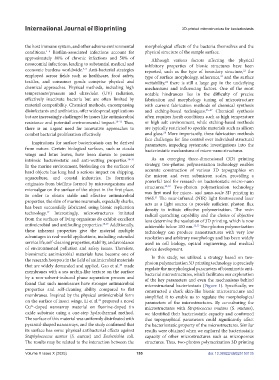Page 163 - v11i4
P. 163
International Journal of Bioprinting 3D-printed microstructure for bacteriostasis
the host immune system, and other adverse environmental morphological effects of the bacteria themselves and the
conditions. Biofilm-associated infections account for physical structure of the sample surface.
4–6
approximately 80% of chronic infections and 50% of Although various factors affecting the physical
nosocomial infections, leading to substantial medical and inhibitory properties of bionic structures have been
7–9
economic burdens worldwide. Anti-bacterial strategies reported, such as the type of boundary structure, the
22
employed across fields such as healthcare, food safety, type of surface morphology, adherence, and the surface
23
textiles, and consumer goods comprise physical and wettability, there is still a large gap in the underlying
24
chemical approaches. Physical methods, including high mechanisms and influencing factors. One of the most
temperature/pressure and ultraviolet (UV) radiation, notable hindrances lies in the difficulty of precise
effectively inactivate bacteria but are often limited by fabrication and morphology tuning of microstructure
material compatibility. Chemical methods, encompassing with current fabrication methods of chemical synthesis
disinfectants and antibiotics, offer widespread applications and etching-based techniques. 25–27 Chemical synthesis
but are increasingly challenged by issues like antimicrobial often requires harsh conditions such as high temperature
resistance and potential environmental impact. 10–13 Thus, or high salt environment, while etching-based methods
there is an urgent need for innovative approaches to are typically restricted to specific materials such as silicon
28
combat bacterial proliferation effectively. and glass. More importantly, these fabrication methods
face challenges for fine control over individual structural
Inspirations for surface bacteriostasis can be derived parameters, impeding systematic investigations into the
from nature. Certain biological surfaces, such as cicada bacteriostatic mechanisms of micro-nano structures.
wings and lotus leaves, have been shown to possess
intrinsic bacteriostatic and anti-wetting properties. 14–16 As an emerging three-dimensional (3D) printing
In the marine environment, biofouling on the surfaces of strategy, two-photon polymerization technology enables
hard objects has long had a serious impact on shipping, accurate construction of various 3D topographies on
aquaculture, and coastal industries. Its formation the micron and even submicron scales, providing a
originates from biofilms formed by microorganisms and powerful tool for research on bacteriostatic micro-nano
29,30
microalgae on the surface of the object in the first place. structures. Two-photon polymerization technology
In order to obtain stable and effective antimicrobial was first used for micro- and nano-scale 3D printing in
1965. The near-infrared (NIR) light femtosecond laser
31
properties, the skin of marine mammals, especially sharks, acts as a light source to provide sufficient photon flux
has been successfully fabricated using bionic replication density to initiate effective polymerization. The resin
technology. Interestingly, microstructures imitated radical quenching capability and the choice of objective
17
from the surfaces of living organisms do exhibit excellent lens determine the resolution of 3D printing, which is now
antimicrobial and antifouling properties. 18,19 Additionally, achievable below 100 nm. 32,33 Two-photon polymerization
these inherent properties give the material multiple technology can produce nanostructures with very low
advantages in real-world applications, including extended resolution and arbitrary morphology and has been widely
service life, self-cleaning properties, stability, and avoidance used in cell biology, optical engineering, and medical
of environmental pollution and safety issues. Therefore, device development.
biomimetic antimicrobial materials have become one of
In this study, we utilized a strategy based on two-
the research hotspots in the field of antimicrobial materials photon polymerization 3D printing technology to precisely
that are widely demanded and applied. Gao et al. made regulate the morphological parameters of biomimetic anti-
20
membranes with a sea urchin-like texture on the surface bacterial microstructures, which facilitates our exploration
by a non-solvent-induced phase separation process and of the key parameters and even the mechanisms behind
found that such membranes have stronger antimicrobial microstructural bacteriostasis (Figure 1). Specifically, we
properties and self-cleaning ability compared to flat constructed a shark skin-like bionic microstructure and
membranes. Inspired by the physical antimicrobial form simplified it to enable us to regulate the morphological
on the surface of insect wings, Li et al. prepared a novel parameters of the microstructures. By co-culturing the
21
2+
Cu -doped nanoarray material on fluorine-doped tin microstructures with Streptococcus mutans (S. mutans),
oxide substrate using a one-step hydrothermal method. we identified their bacteriostatic capacity and confirmed
The surface of this material was uniformly distributed with that topographical parameters could significantly affect
pyramid-shaped nanoarrays, and the study confirmed that the bacteriostatic property of the microstructures. Similar
its surface has some physical antibacterial effects against results were obtained when we explored the bacteriostatic
Staphylococcus aureus (S. aureus) and Escherichia coli. capacity of other microstructures such as microporous
The results may be related to the interaction between the structures. Thus, two-photon polymerization 3D printing
Volume X Issue X (2025) 155 doi: 10.36922/IJB025150135

